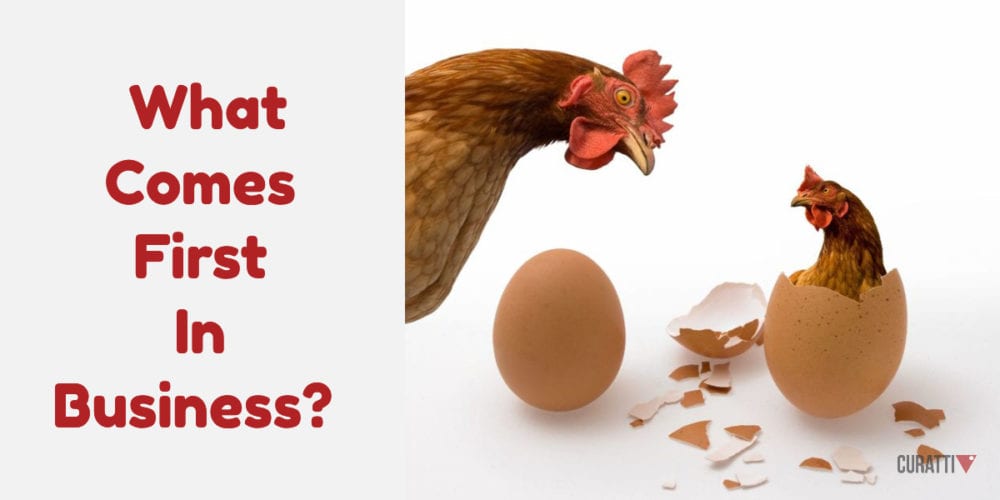Chickens, Eggs, and Business: What Comes First? 20 (Or So) Questions

Editor’s note: This post is not only aimed at those starting out in business. Slightly modified versions of these questions are relevant for those seeking to make new offerings or take their existing business in a new direction.
I admit to never quite seeing the conundrum in the chicken and egg question. I believe in evolution, so the modern chicken came from its egg. Simple!
Marketing, however, is altogether more difficult. What comes first there?
You need a product or service to start with, right?
But who will you sell to?
So maybe you need an audience/potential customer base first?
But who will your audience be?
How will you attain your audience? Building it purely organically takes so long now, but what startup can afford advertising!
- Will this new audience one day become customers of whatever you decide to sell?
- Might they only think of you in terms of what you’ve always given them for free?
- Have you diminished your perceived value by being a free resource?
What if a changing marketing arena means that what you thought you would sell when you got started, is no longer viable when you have an audience?
What if the audience you painstakingly acquired, isn’t interested in paying for what you want to sell?
You may also want to read: How Long Does It Take To Rank In Google? [Infographic]
So, What Really Does Come First?
I think that the correct answer is, ‘it depends’!
The most ideal scenario – but one that won’t be cheap – is that you:
- Have a product or service
- Go through the steps to determine who will buy it
- Go after that audience with blog, paid and organic social media, (possibly compensated) advocates…
The second best, but far ‘cheaper’ option has been:
- Build your following organically, targeting an audience that matches your interests. Because common wisdom (not always right!) suggests you stand a better chance of succeeding in business if you follow your passion
- Know that you’re highly likely to not attract the people you thought you would, despite being convinced that they are the people who will be drawn to your content
- ALWAYS check your analytics to:
-
- Make sure you’re reaching the people you’re hoping to reach
- Tweak your content if your blog visitors/social media connections and followers aren’t who you thought they’d be
- Or
- If feasible, consider adjusting your targeted offerings to match your now ready-made audience
-
- Always be aware that in the time it takes you to organically grow an audience, the marketing and tech landscape WILL change. So, BE PREPARED TO PIVOT!
Were you wondering why I put cheaper in inverted commas? Just in case you were…
Time ain’t cheap, even if your actual money expenditure is low. Not really. It comes at various costs, including work-life balance, years without a real vacation and the added stress of always having more to do than you can get to. So, this ‘cheap’ comes at other costs.
You may also want to read: How to Leverage Social Selling To Dominate Your eCommerce Niche
What If There was a Third Way?
I’ve been trying to wrap my head around this one since I first saw the suggestion:
Can you pick an ideal customer before you have something to sell them?
On the face of it, this is just a tweak on going after an audience first. Can you really settle on products or services after you determine the ideal customer? I’d not previously seen this suggested or considered it as an option.
It’s counter-intuitive, isn’t It?
How Would It Work?
Ultimately, you won’t sell anything that people don’t need – or can’t easily be convinced that they need. When looking for the perfect customer first, you obviously have a very good idea of the type of person who might want something you can provide. So maybe, by interacting with your ideal customers before producing anything, you can find out what this ideal customer needs?
Is This Way Better?
The way we’ve done things until now requires more work than this. The over-simplified version of doing it as a start-up was mentioned above.
For existing businesses with an established readership/subscriber base/customer base, that would have entailed:
Either: Marketing directly to them (and hoping they like it enough to buy), before expanding your marketing efforts
Or: Polling the existing base as to whether they would be interested before pressing too far ahead. And if the answer was no? Then what? Marketing your wares only to new people? Maybe abandoning your efforts?
What Do You Think?
I can see the logic in this new, third way. It seems to cut down on the steps and make success more likely. What do you think?
This article by Neil Patel is far more comprehensive. An excellent, detailed guide.
Sign Up For Our Mailing List
If you’d like to receive more in-depth articles, videos and Infographics in your inbox, please sign up below

Sign up for the newest articles from Curatti, delivered straight to your inbox
Featured image: Copyright: ‘https://www.123rf.com/profile_Vladimirs‘ / 123RF Stock Photo
Andy Capaloff
Latest posts by Andy Capaloff (see all)
- The Art of Asking Questions [Interactive] - October 17, 2023
- The Metaverse Is Not Dead. It’s Resting! - September 6, 2023
- How Can You Hire For Jobs That Nobody Has Experience In? Aptitude! - June 13, 2023
